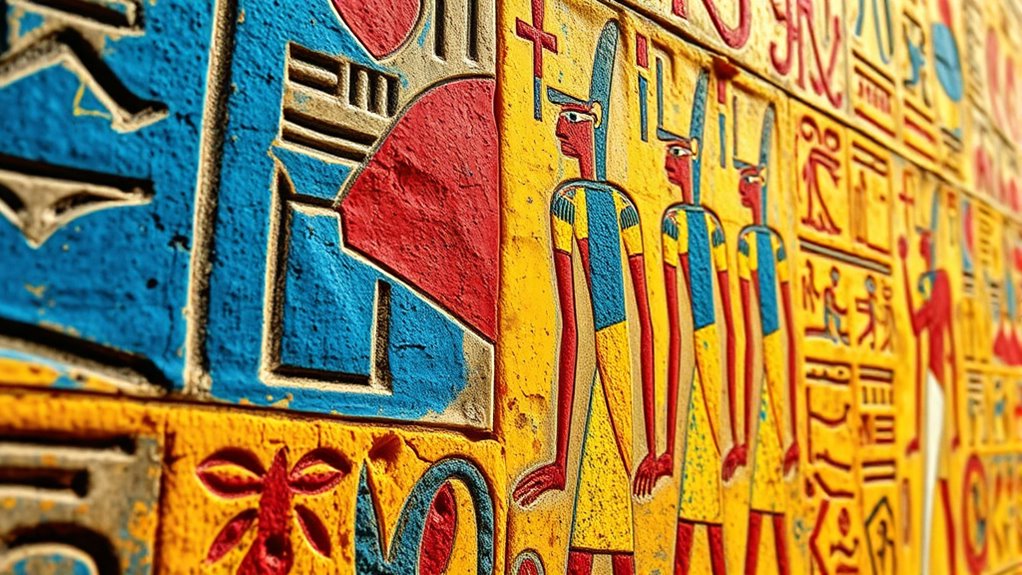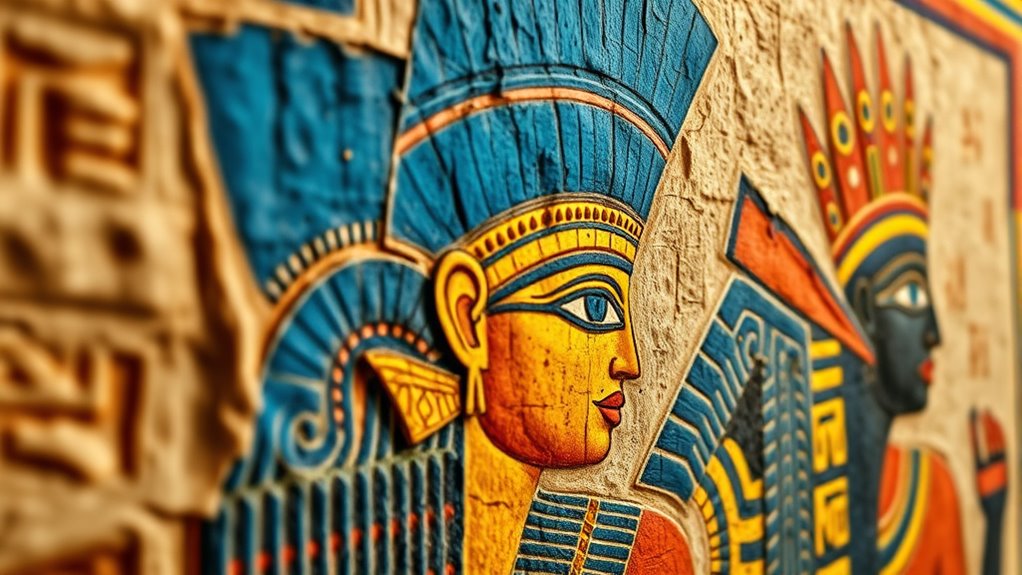Colors in ancient Egyptian art hold deep symbolic meanings that reflect their spiritual beliefs. For instance, red can represent vitality or chaos, while blue symbolizes the divine and water. Green stands for rebirth and growth, and black signifies death and resurrection. These colors were carefully chosen for their divine significance and durability, often conveying messages about gods, the afterlife, or protection. If you explore further, you’ll discover how these hues shaped their mythology and artistic practices.
Key Takeaways
- Colors in Egyptian art symbolize concepts like life, death, rebirth, divine power, and cosmic messages.
- Specific pigments, such as lapis lazuli and malachite, were sourced from natural materials with symbolic meanings.
- Red, blue, green, black, and white each had distinct spiritual and mythological significance in artworks and rituals.
- Artistic use of color emphasized divine qualities and mythological narratives, like Osiris’s green skin for rebirth.
- Colors were believed to offer protective qualities, enhancing the spiritual power and durability of artworks and amulets.

Colors played an essential role in ancient Egyptian art and mythology, conveying meaning and spiritual significance. As you study their artwork, you’ll notice how each hue isn’t just decorative but deeply symbolic, representing concepts like life, death, rebirth, and divine power. The Egyptians believed that colors could communicate messages beyond words, helping to connect the earthly domain with the divine. Understanding these symbolic meanings allows you to better appreciate the depth behind their artistic choices and rituals. The vibrant palette was achieved through carefully sourced pigments, which were often derived from natural materials. For example, the bright red was typically made from ochre, a mineral pigment abundant in the landscape, symbolizing chaos or vitality depending on its context. Blue, associated with the heavens and water, was created using a semi-precious stone called lapis lazuli, imported from distant lands, emphasizing its divine and royal significance. Green, representing fertility and renewal, came from malachite, a mineral that symbolized growth and rebirth. Black, standing for death, the afterlife, and fertility, was derived from carbon-based substances like soot or charcoal, which also linked to the concept of resurrection. White, often used in ceremonial contexts, was made from chalk or gypsum and signified purity and sacredness. These pigment sources weren’t just chosen for their color but also for their spiritual associations, reinforcing the message each artwork aimed to communicate. When you observe Egyptian murals or statues, notice how the colors are applied with precision, often in accordance with their symbolic meanings. You’ll see that gods and pharaohs are frequently depicted with specific colors to emphasize their divine qualities or their roles within mythological narratives. For instance, Osiris is often shown with green skin, symbolizing rebirth, while Hathor might be painted in vibrant reds and golds, representing her divine power. The Egyptians also believed that colors had protective qualities, which is why they were used in amulets and burial masks. The careful selection of pigment sources and their symbolic meanings wasn’t accidental but a deliberate effort to imbue art with spiritual power. As you explore ancient Egyptian art, remember that each hue carries a layered significance, shaping stories of the cosmos, the divine, and the afterlife. Their mastery of color was more than aesthetic; it was a sacred language that communicated complex beliefs and maintained the divine order, making their art an enduring record of their spiritual worldview. Additionally, the source of pigments played a crucial role in the durability and longevity of their artworks, ensuring these symbols endured through millennia.
Frequently Asked Questions
How Did Ancient Egyptians Produce Their Vibrant Pigments?
You might be surprised to learn that ancient Egyptians produced vibrant pigments through ancient pigment extraction, where they carefully mined minerals like malachite and lapis lazuli. They also engaged in the trade of mineral dyes, bringing in rare materials from distant regions. These methods allowed them to create the striking colors seen in their art, reflecting both their advanced craftsmanship and extensive trade networks.
Were Certain Colors Reserved for Specific Social Classes?
Some scholars believe social class color distinctions existed in ancient Egypt, but evidence remains inconclusive. You might think that certain colors, like gold or deep blue, were reserved for royalty due to their religious symbolism and association with divine power. However, while specific hues held symbolic meaning, many colors were accessible across social classes, emphasizing spiritual significance rather than strict social hierarchy. The intertwining of religion and color likely influenced usage more than social stratification.
How Did Color Symbolism Evolve Over Different Egyptian Dynasties?
Over different Egyptian dynasties, you see dynastic color symbolism shift as religious color associations evolved. Early on, colors like green and black represented fertility and rebirth, while later, gold symbolized divinity. You notice that these meanings become more complex, reflecting changes in religious beliefs and social hierarchies. This progression shows how Egyptian culture integrated color symbolism into their spiritual and political life across centuries.
Did Color Choices Vary Between Regions or Cities in Egypt?
Ever think Egyptian artists played favorites? Well, they did! Regional color preferences and city-based pigment differences meant that Cairo’s reds might differ from Thebes’ blues. Local resources, trade routes, and cultural influences shaped these choices, making each city’s art uniquely vibrant. So, next time you admire an ancient mural, remember—its colors tell a story not just of mythology but of regional pride and pigment politics.
Are There Any Surviving Ancient Egyptian Color Recipes or Formulas?
Yes, some ancient Egyptian pigment recipes and color formulas have survived, allowing us to understand their techniques. You can find preserved Ancient pigment recipes in tomb paintings, papyri, and artifacts. These documents reveal how they mixed minerals and other ingredients to create vibrant colors. The preservation of color formulas helps researchers study their artistic methods and guarantees we appreciate the skill and knowledge behind ancient Egyptian art today.
Conclusion
As you explore the vibrant world of ancient Egyptian art and myth, remember that colors held deep symbolic meaning, reflecting their beliefs and values. They believed that “a picture is worth a thousand words,” and the hues they used spoke volumes about their spirituality and culture. By understanding these colors, you gain insight into their world—where every shade told a story. So, keep in mind, beauty and meaning often go hand in hand, like night and day.









